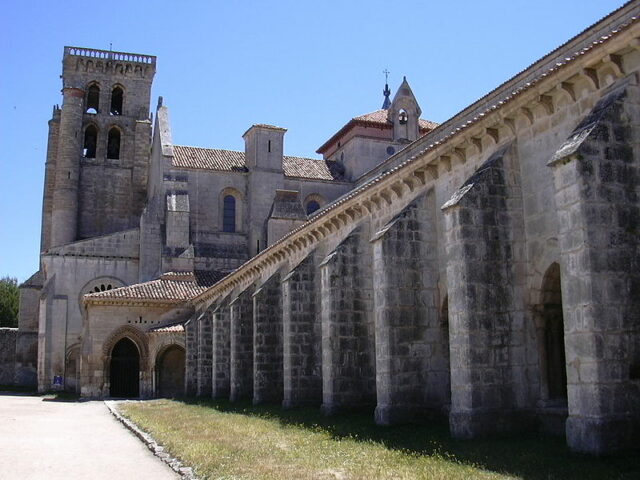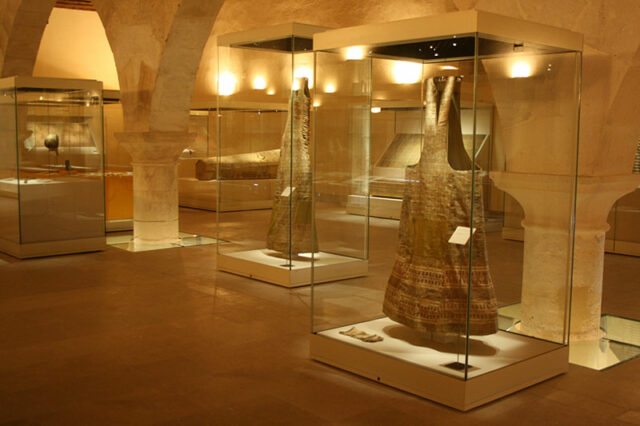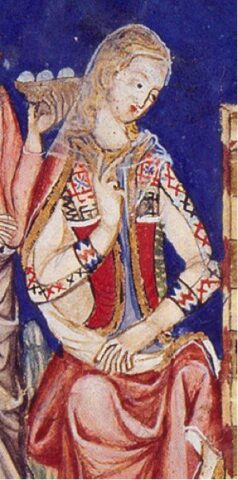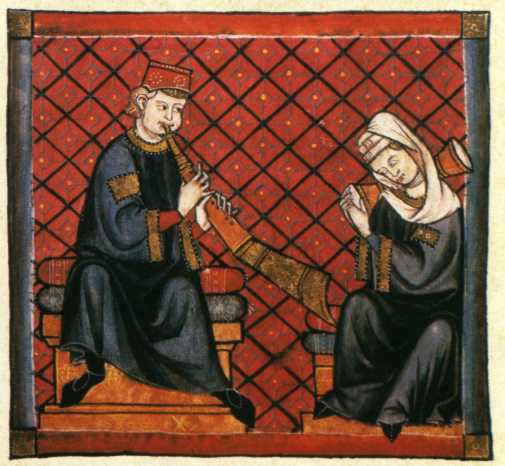As instructed, this post includes sources that inspired my ensemble. The chief sources are the funeral gown of Leonor de Castilla, a granddaughter of Eleanor of Aquitaine and Henry Plantagenet, a princess royal of Castilla and a queen of Aragón for a time, and images from Libro de Ajedres, Dados, y Tablas and the Cantigas de Santa Maria by Alfonso X el Sabio.
Leonor de Castilla (1200-1244) was buried with other Castilian royalty at the Monasterio de Santa Maria la Real de Las Huelgas in Burgos. That monastery managed to escape the ravages of the Napoleonic wars, so the remains of the royalty there were left undisturbed until the limestone sepulchers were opened in 1947 for historic purposes. The remains of these royal dead were in remarkably good condition, had been expertly embalmed so the corpses were mummified, and reportedly had a sweet smell about them. Their clothing was also in good condition under the circumstances. The camisas next to the skin were the most degraded, but the silks atop those had maintained their integrity, if not their burial coloring. The bodies were examined and respectfully re-interred, while the clothing has been restored as much as possible, and Leonor’s gown of silk brocade in particular became the signature piece of the Museo de las Ricas Telas (or Museo de Telas Medievales). The active monastery of Cistercian nuns is still there, but it also houses the museum.

It also houses the Museo de Telas Medievales, Burgos, Spain.

Alfonso X the Wise (1221-1284), the polymath, was at the center of a great cultural flowering of his kingdom. Among the many works he commissioned is what we call the Book of Games, but is more actually titled Libro de Ajedres, Dados, y Tablas, the Book of Chess, Dice, and Boards, published around 1280. It illustrates the varied people of his kingdom (Christians, Jews, and Moors) playing at the different board games whose rules he listed for entertainment and education. Some of the female models for these illuminations are said to be his daughters. The camisas of the 1280s are depicted as elaborately embroidered, and the pellotes are trimmed, either with fur or with wool, but it is hard to tell with drawings, as there are few if any extant examples. The young lady here is seen with a very sheer veil headdress, and her hair is loose. She is young and unmarried.

A married woman would have her hair more suitably covered, veiled in more opaque rectangular fabric. She might also have use of a toca (or tocado), a hat that could be tall and elaborate, or she might cover her hair with a snood (a crespina), a barbette (barboquejo), and fillet, the fillet often covered with a light veil. I have no illusions regarding my age. The one toca I have doesn’t quite match what I am making, so I will be making do with the snood, linen barboquejo and fillet, and a nice fringed white silk veil. An example of an adult woman’s headdress comes from Alfonso X’s Cantigas de Santa Maria, a collection of hymns to Mary that he commissioned in the 1280s, though he also contributed.

Some Sources
- Feminae: Medieval Women and Gender Index. “Pellote of Leonor, Queen of Castile.”
https://inpress.lib.uiowa.edu/feminae/DetailsPage.aspx?Feminae_ID=37095.
- Gómez Moreno, Manuel. “Historia y arte en el panteón de las Huelgas de Burgos.” Arbor 7, 21 (1947): 397-434.
- Lindahl, Greg. The Cantigas de Santa Maria. http://www.pbm.com/~lindahl/cantigas/.
- Villanueva, Ana. Indumentarse medieval. “Saya encordada de Leonor de Castilla.” https://indumentarsemedieval.blogspot.com/2014/09/saya-encordada-de-leonor-de-castilla.html.
Sources of Images:
- The images of the extant saya and pellote come from the Feminae website, but are originally from that of the Museo de Telas Medievales, Burgos, Spain.
- The draft for the saya encordada that inspired my own pattern came from Ana Villanueva’s blog listed above.
- The idea for the eyelet tape likewise came from Ms. Villanueva’s blog.
- The image detail of the young lady sitting next to a chess board is originally from the Libro de Ajedres, this image from the Feminae website.
- The image of the exterior of the Monasterio and Museo comes from Wikimedia Commons, User: Ecelan.
- The image of the interior of the museum is from: http://htexpomuseos.com/exposiciones/museo-de-telas-medievales/
- The image from Cantiga de Santa Maria No. 300 comes from The Cantigas de Santa Maria: Illuminations, http://www.pbm.com/~lindahl/cantigas/images/cantiga_15small.jpg, a subpage of the Cantigas de Santa Maria Home Page of Greg Lindahl.

